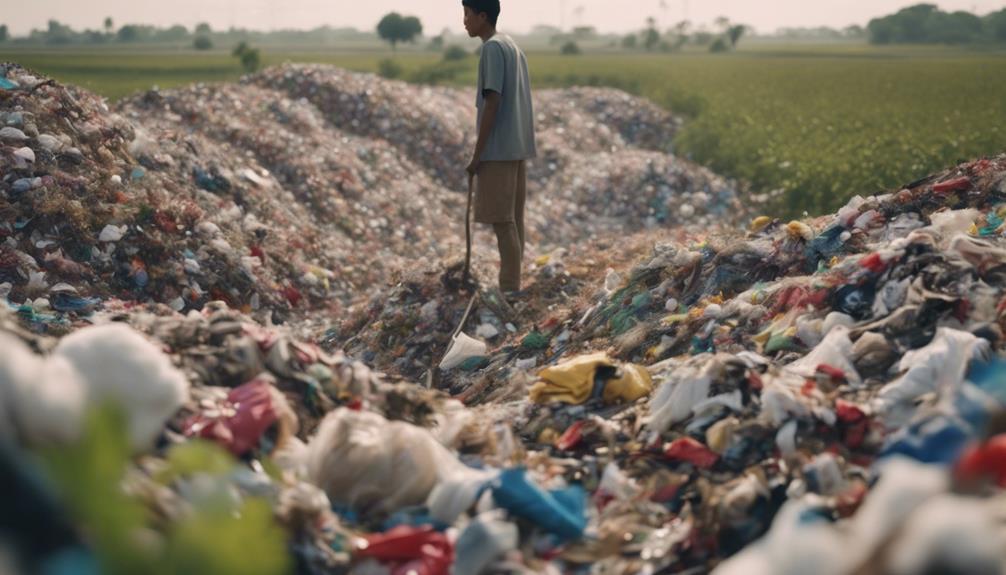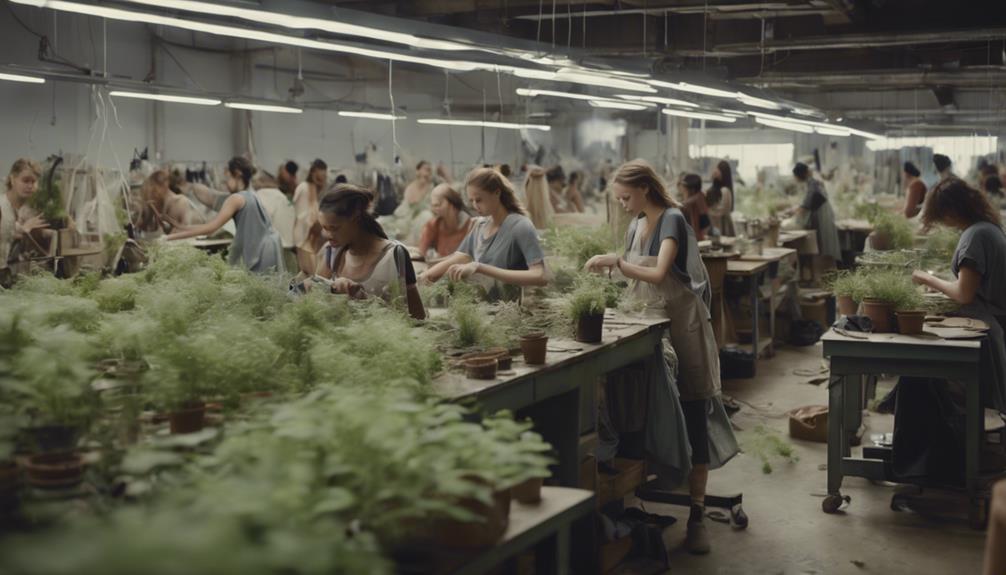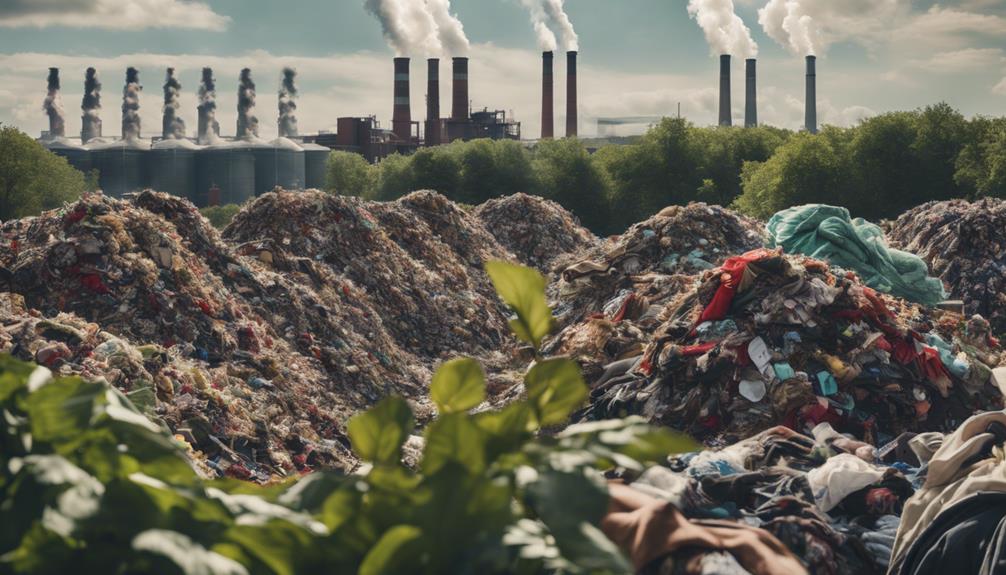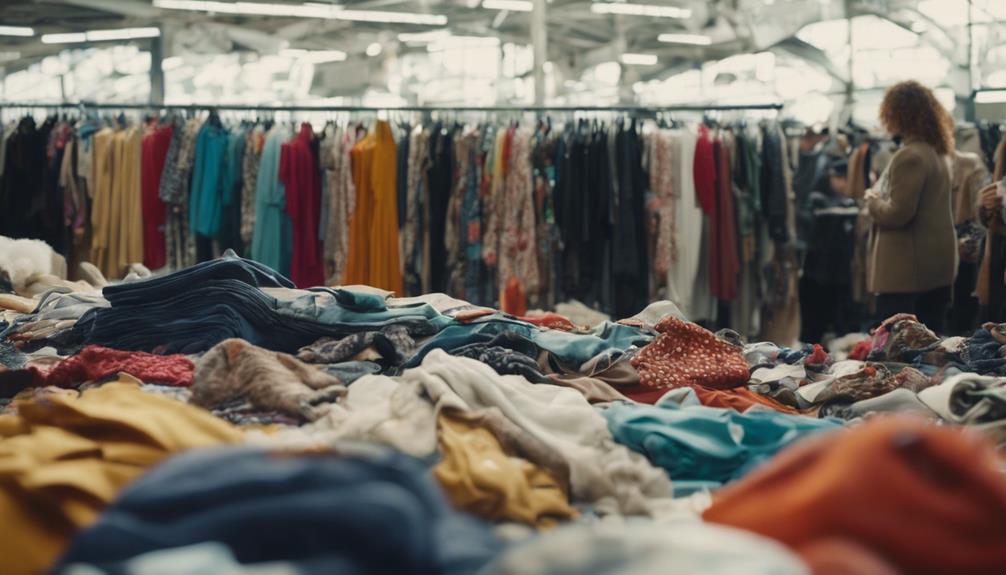Fast fashion focuses on quick production and cost efficiency, resulting in significant waste and detrimental effects on the environment. Approximately 100 billion garments are manufactured each year, many of which end up in landfills shortly after purchase. Conversely, sustainable fashion emphasizes quality, ethical labor, and environmentally friendly materials in an effort to reduce waste and carbon emissions. It advocates for a circular economy through practices like thrifting. While fast fashion may fill your closet rapidly, sustainable fashion advocates for the planet and its inhabitants. Embrace the shift towards more responsible choices, and you may be pleasantly surprised by what you find next!
Key Takeaways
- Fast fashion produces around 100 billion garments annually, promoting a disposable mindset that leads to significant waste and environmental harm.
- Sustainable fashion prioritizes eco-friendly materials, ethical labor practices, and aims to minimize waste and carbon emissions.
- Fast fashion contributes 8-10% of global carbon emissions and 20% of water waste, while sustainable fashion seeks to reduce these impacts.
- The fast fashion model often relies on exploitative labor practices, whereas sustainable fashion emphasizes fair wages and safe working conditions.
Understanding Fast Fashion
Fast fashion is all about quickly producing trendy clothing at a massive scale, leading to an astonishing 100 billion garments flooding the market each year. Fast fashion companies, like Zara and H&M, thrive on this model, churning out millions of garments to meet ever-changing consumer demands. This constant cycle of production creates a culture where you often purchase clothes for fleeting moments, rather than for longevity.
However, this convenience comes with significant negative impacts. The rapid turnover of styles encourages you to buy more and discard quickly, resulting in a disposable mindset towards clothing. Many garments are made from low-quality materials, contributing to their short lifespan. This means that a staggering percentage of clothing—around 33%—ends up in landfills within just a year of purchase.
Moreover, the fast fashion industry's focus on speed and cost cuts often compromises ethical labor practices. Workers face poor conditions, long hours, and low wages in factories, adding a layer of social responsibility to your purchasing decisions. Understanding these aspects helps you realize the broader implications of your choices in fashion and encourages a shift toward more sustainable practices.
The Environmental Toll

The environmental toll of fast fashion is staggering, contributing considerably to climate change and overwhelming landfills with discarded garments. Did you know that fast fashion accounts for 2-8% of global carbon emissions? That's a significant impact on our planet's health.
What's even more alarming is that about 33% of the clothing produced in this industry ends up in landfills within just a year of purchase, generating massive waste.
Additionally, fast fashion is responsible for 20% of global water waste, intensifying water scarcity in various regions. The production processes often use harmful chemicals, like Azo dyes, which pollute water sources and threaten ecosystems.
In contrast, sustainable fashion brands prioritize eco-friendly production methods, aiming to reduce both waste and carbon emissions. They focus on creating higher quality garments that last longer, therefore minimizing the environmental impact.
Ethical Issues in Fast Fashion

Ethical issues in fast fashion stem from exploitative labor practices that prioritize profit over the well-being of workers. Many garments are produced in developing countries where workers earn less than livable wages and endure unsafe working conditions. With around 40 million individuals employed in the global garment industry, excessive hours and a lack of rights are common experiences.
You should know that approximately 85% of garment workers are women, who often face gender-based discrimination, compounding the ethical issues within this industry. Child labor is also a significant concern, as some brands have been accused of employing underage workers to cut costs.
The lack of transparency in supply chains makes it difficult for you to understand where your clothing comes from and the conditions under which it was made. With such exploitative practices at play, it becomes clear that fast fashion thrives on unethical standards.
As a consumer, your purchasing decisions can support or challenge these practices, so it's essential to be informed. By choosing ethically made clothing, you can help advocate for better working conditions and support a more sustainable fashion industry.
Defining Sustainable Fashion

Sustainable fashion prioritizes environmentally friendly methods and fair labor practices, offering a responsible alternative to conventional clothing production. This approach focuses on creating garments that minimize waste and reduce carbon emissions, addressing the serious environmental issues caused by fast fashion, which contributes 2-8% of global emissions annually.
At its core, sustainable fashion is ethical, promoting fair labor conditions and ensuring that workers earn livable wages. This stands in stark contrast to the exploitative labor practices often associated with fast fashion. High-quality garments are a hallmark of sustainable fashion, leading to products that last longer and greatly reduce landfill contributions. Approximately 33% of fast fashion clothing ends up in landfills within just one year of purchase.
Additionally, sustainable fashion encourages practices like thrifting and clothing swaps, fostering a more circular economy that combats the culture of constant consumption. By avoiding harmful chemicals and prioritizing eco-friendly materials, sustainable fashion not only protects the environment but also supports a healthier planet for future generations.
This growing movement reflects a rising consumer demand for ethical and environmentally conscious alternatives in the fashion industry.
Benefits of Sustainable Practices

Sustainable practices in fashion offer you a chance to support environmental preservation while promoting ethical labor conditions.
By choosing eco-friendly materials and fair labor practices, you help reduce carbon emissions and waste.
This shift not only benefits the planet but also fosters a more just industry for workers.
Environmental Preservation Efforts
Embracing eco-friendly practices in fashion can drastically reduce environmental impact and promote a healthier planet for future generations.
Sustainable fashion focuses on high-quality production methods, which extend garment lifespans. By doing this, you help combat the alarming statistic that 33% of clothing ends up in landfills within the first year of purchase.
Additionally, sustainable fashion minimizes carbon emissions, contributing only 2-8% compared to fast fashion's 8-10%. This significant reduction highlights the urgent need for change in consumer habits. Eco-friendly materials and practices also address the 20% of water waste linked to fast fashion manufacturing processes, further lowering the environmental impact.
Moreover, sustainable fashion encourages recycling, upcycling, and thrifting, fostering a circular economy that reduces overall waste. By supporting these initiatives, you not only contribute to environmental preservation but also drive market growth for sustainable options, projected to reach $9,808.5 million by 2025.
Your choices in fashion can be a powerful tool in the fight against environmental degradation. Choosing sustainable practices not only benefits you but also guarantees a more sustainable future for our planet.
Ethical Labor Practices
Ethical labor practices in fashion guarantee fair wages and safe working conditions, directly benefiting workers and their communities. When you choose sustainable fashion over the fast fashion industry, you're not just buying clothes; you're supporting a movement that values human rights.
Here are three key benefits of embracing ethical labor practices:
- Fair Wages: Sustainable fashion brands guarantee workers receive fair pay that meets or exceeds living standards, helping them escape poverty.
- Safe Working Conditions: Companies committed to ethical labor practices prioritize safety, providing workers with environments that comply with strict health and safety regulations.
- Transparency: By promoting transparency in their supply chains, sustainable brands allow you to know where and how your clothing is made, in stark contrast to the hidden exploitation often found in the fast fashion industry.
Economic Impact of Both Models

The economic impact of fast fashion is staggering, with the industry valued at around $100 billion and projected to continue its rapid growth. In contrast, sustainable fashion, though on the rise, still struggles to reach a fraction of that market size.
Major fast fashion brands, like Zara and H&M, produce approximately 8 billion garments annually, fueling a cycle of constant consumption and disposal. This model contributes to about 33% of clothing ending up in landfills within the first year of purchase.
Fast fashion's rapid trend cycles, driven by online retailers and social media, have led to significant environmental costs, accounting for 8-10% of global carbon emissions and 20% of water waste.
In contrast, sustainable fashion promotes durable, high-quality clothing investments that can help reduce waste and emissions. However, it often faces higher production costs, making it less accessible for low-income consumers.
While fast fashion thrives on affordability and accessibility, sustainable fashion's slower growth reflects its commitment to environmental and ethical practices.
Ultimately, choosing between these models affects not just your wardrobe but the wider economy and the planet's health.
The Role of Consumer Awareness

Consumer awareness greatly drives the shift from fast fashion to sustainable alternatives, as more shoppers prioritize quality and ethical practices in their clothing choices.
As you become more informed, it's crucial to recognize the impact your decisions have on the environment and society. Here are three ways consumer awareness promotes sustainable fashion:
- Education on Environmental Impact: Understanding that fast fashion contributes to 2-8% of global carbon emissions encourages you to seek eco-friendly options.
- Social Media Influence: Platforms like Instagram and TikTok expose the harsh realities of fast fashion, making you more inclined to support brands that champion sustainability.
- Support for Ethical Brands: Recognizing exploitative labor practices pushes you to choose clothing from companies that prioritize fair labor conditions and transparency.
As sustainable fashion is projected to grow considerably, your purchasing decisions can help shift the industry towards more responsible practices.
By being mindful of where you shop and what you buy, you not only enhance your wardrobe but also contribute to a more sustainable future.
Embrace the power of consumer awareness, and make choices that reflect your values.
Future Trends in Fashion

As you look ahead in the fashion world, you'll notice a strong push towards eco-friendly production methods that prioritize the planet.
With consumer awareness growing, more people are demanding sustainable options that reflect their values.
This shift not only changes how brands operate but also sets the stage for a more responsible industry overall.
Eco-Friendly Production Methods
Embracing eco-friendly production methods is becoming essential for fashion brands aiming to reduce environmental impact and meet the growing demand for sustainability.
Sustainable fashion focuses on practices that minimize waste and promote responsible consumption. As you explore this evolving landscape, here are three key eco-friendly production methods to reflect upon:
- Organic Materials: Brands are increasingly using organic cotton, hemp, and other natural fibers that require less water and eliminate harmful pesticides, unlike synthetic options.
- Closed-Loop Systems: Innovative technologies allow brands to recycle materials back into the production process, minimizing waste and extending the lifecycle of garments.
- Biodegradable Fabrics: Fashion companies are developing fabrics that break down naturally, reducing landfill waste and environmental harm.
Consumer Awareness Growth
Awareness of the harmful effects of fast fashion is skyrocketing, driving a significant shift towards sustainable fashion choices among shoppers. As you navigate the world of fashion, it's vital to recognize the impact your choices have on the environment and society. With consumer awareness on the rise, more people are prioritizing ethical brands that align with their values.
Social media plays a huge role in this transformation, educating you about the ethical practices behind your clothing. Platforms highlight the environmental consequences of fast fashion, making it easier for you to make informed decisions. Events like Eco Fashion Week, launched in 2009, have sparked global movements that elevate sustainable fashion and ethical brands, showcasing the growing demand for responsible options.
Major fashion weeks are also embracing sustainable practices, reflecting your desire for eco-friendly choices. Brands like Oliberté are leading the charge, emphasizing quality and responsibility over the fleeting nature of fast fashion.
As consumer awareness continues to climb, you're part of a powerful shift that prioritizes sustainable fashion for a better future. Your choices today can help redefine the fashion industry tomorrow.
Frequently Asked Questions
What Is the Difference Between Sustainable and Fast Fashion?
Sustainable fashion focuses on ethical production, quality, and durability, while fast fashion prioritizes speed and low cost. You'll find sustainable pieces last longer and minimize environmental impact, whereas fast fashion promotes a disposable culture. Thrifting for sustainable fashion is a great way to incorporate eco-friendly choices into your wardrobe. By purchasing second-hand clothing, you’re reducing the demand for new production and extending the life of clothing that may have otherwise ended up in a landfill. Additionally, thrifting allows for unique and one-of-a-kind finds, adding a personal touch to your style while supporting sustainability.
What Is the Difference Between Fast Fashion and Fashion?
Imagine a whirlwind of trends, where clothing flies off shelves. Fast fashion captures this chaos, offering cheap, fleeting styles. In contrast, fashion embraces creativity and quality, crafting timeless pieces that resonate beyond mere trends.
Why Do People Choose Fast Fashion Over Sustainable Fashion?
You choose fast fashion for its affordability and access to the latest trends. The convenience of online shopping and the culture of immediacy often overshadow the long-term environmental impacts of your clothing choices.
What Is the Difference Between Sustainable Fashion and Ethical Fashion?
Sustainable fashion focuses on eco-friendly practices and reducing environmental impact, while ethical fashion emphasizes fair labor practices and worker well-being. Both aim for quality, but their priorities differ regarding ecological versus social justice issues.
Conclusion
In the tangled world of fashion, it's easy to get swept up in fast trends, but remember: your choices shape the industry.
Coincidentally, when you opt for sustainable fashion, you're not just looking good; you're supporting a healthier planet and fairer labor practices.
The truth is, each purchase you make can echo beyond your wardrobe, influencing future trends and sparking change.
So, why not wear your values and make a statement that lasts?









